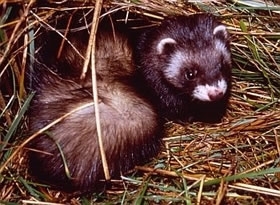Polecat
 I have chosen the polecat as my species for this month, as I came face to face with one in the headlights of my car the other evening, as I drove up the single track lane to my house in central Hampshire. It was not a long meeting, but it gave me enough of its time to be fairly certain that it was a true polecat and not a “polecat ferret”.
I have chosen the polecat as my species for this month, as I came face to face with one in the headlights of my car the other evening, as I drove up the single track lane to my house in central Hampshire. It was not a long meeting, but it gave me enough of its time to be fairly certain that it was a true polecat and not a “polecat ferret”.
The character I saw had the typical “bandit” features of pale cheek patches and white behind the dark face mask and had no sign of any pale throat patch, which a cross polecat and feral ferret usual possesses. Its body also appeared almost black in the headlights, whereas the hybrid usually has a much paler body and quite often white paws too.
The polecat used to be widely distributed across the country, but by the early 1900s it had been reduced to a population estimated to be around 5,000, based on central Wales. It was persecuted by farmers and gamekeepers largely because of its wide and varied diet, which quite often included gamebirds and domestic fowl. Indeed the name polecat probably comes from the old French words “pole chat” (poule in modern French) meaning chicken cat.
Where rabbits are plentiful, they make up a major part of the diet as polecats are slim enough to hunt them within their burrows. In winter, rats become a preferred food, and sites with good rat populations such as around farm buildings become the usual haunt for this largely nocturnal species. However, the polecat is nothing if it is not an opportunist and so any potential prey that presents itself in a vulnerable position, is dicing with death! A good example of this is during the late winter spawning period for frogs and toads, when many will be consumed by the local polecat!
The polecat female which is called a jill, (male is a hob) brings up the young kittens or kits, as they are usually called, completely on her own. She often chooses a rabbit burrow, log pile or even under a garden shed to make her den.
Radio tracking has shown that a polecat’s territory can vary widely in size, probably dependent on the quality of available habitat and food availability. Male polecats can range over an area of up to 500 ha, while females may utilise an area as big as 375 ha. On occasions, however, when there is an ample food supply, the area over which they travel can be as little as 16 ha.
Polecats have one litter a year, with 5-10 young born blind and hairless in late May or early June. They begin to take meat from three weeks, and stay with their mothers for 2-3 months. They reach adult size by autumn, and breed at one year old.
Now that the polecat is fully protected under the Wildlife and Countryside Act 1981, it seems to be continuing its range expansion from its historical stronghold in mid Wales, into the Midlands, and southern and eastern English counties. There are also pockets where the species appears to exist, probably following introductions, in the north of England and Scotland.
To give us a better understanding of this expansion, the Vincent Wildlife Trust (VWT) is carrying out a national polecat survey, which aims to gather up-to-date information on the distribution of the polecat in Britain, and they are keen to receive any current records and carcasses (collected during 2014-2015) of wild-living polecats or feral ferrets.
So, if you have encountered this masked mammal on your travels, or found one squished on the road, why not send your record into the VWT – you have just two months left before the survey finishes!
One final little ditty on polecats for you, which you might consider squeezing into the pub quiz! A group of polecats is known as a “chine”.
Peter Thompson
Advisory
Read more from Peter Thompson at his blog.

Download Peter Thompson's essential 26-page book, featuring beautiful photography and detailed profiles of Britain's wildlife
Download FREE >